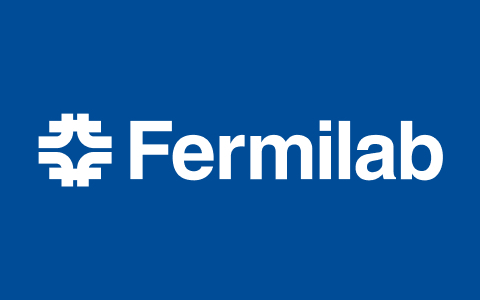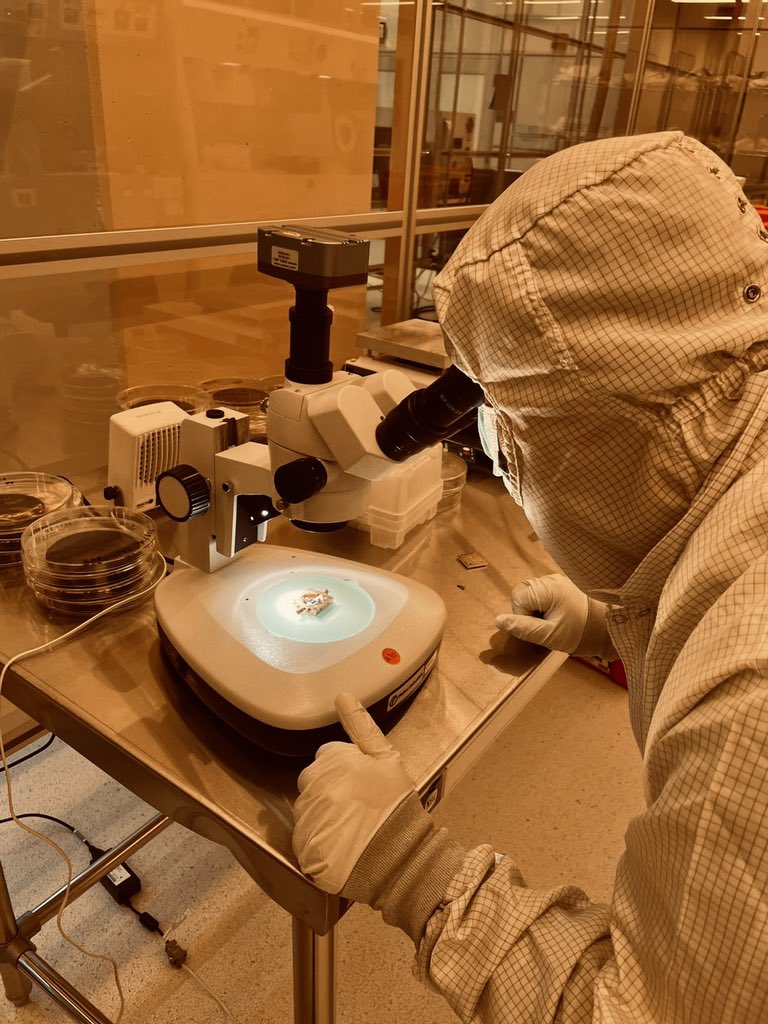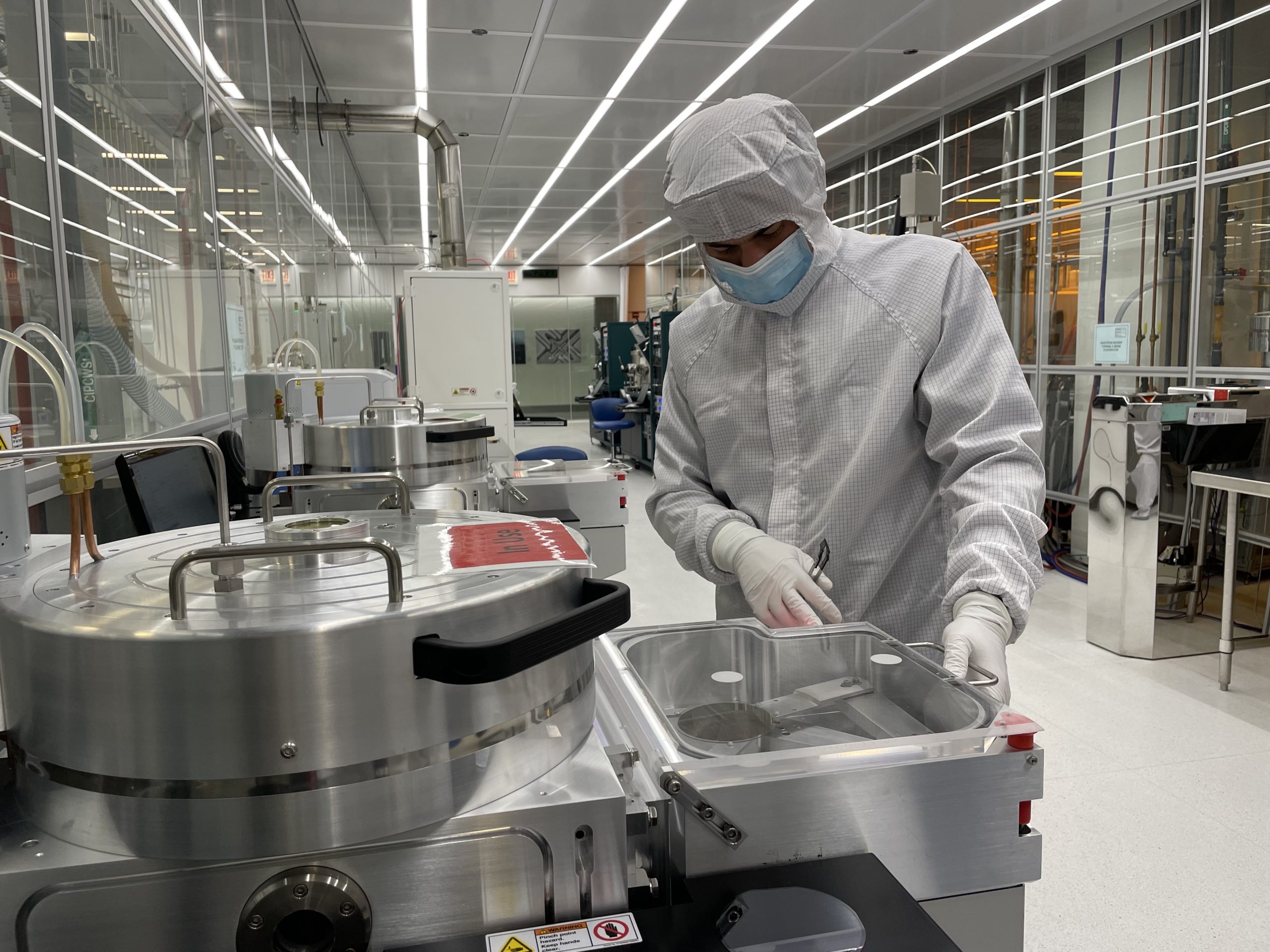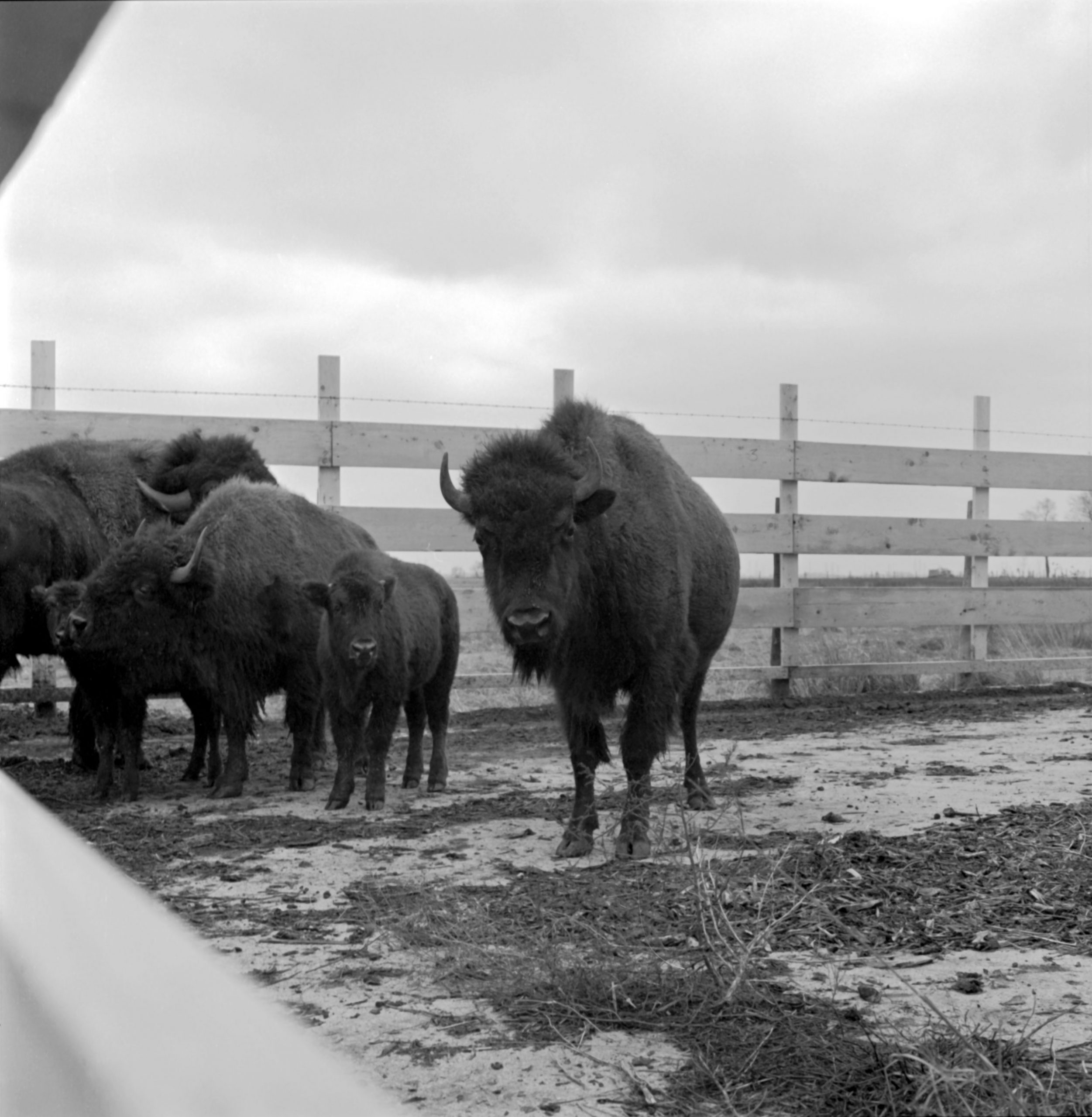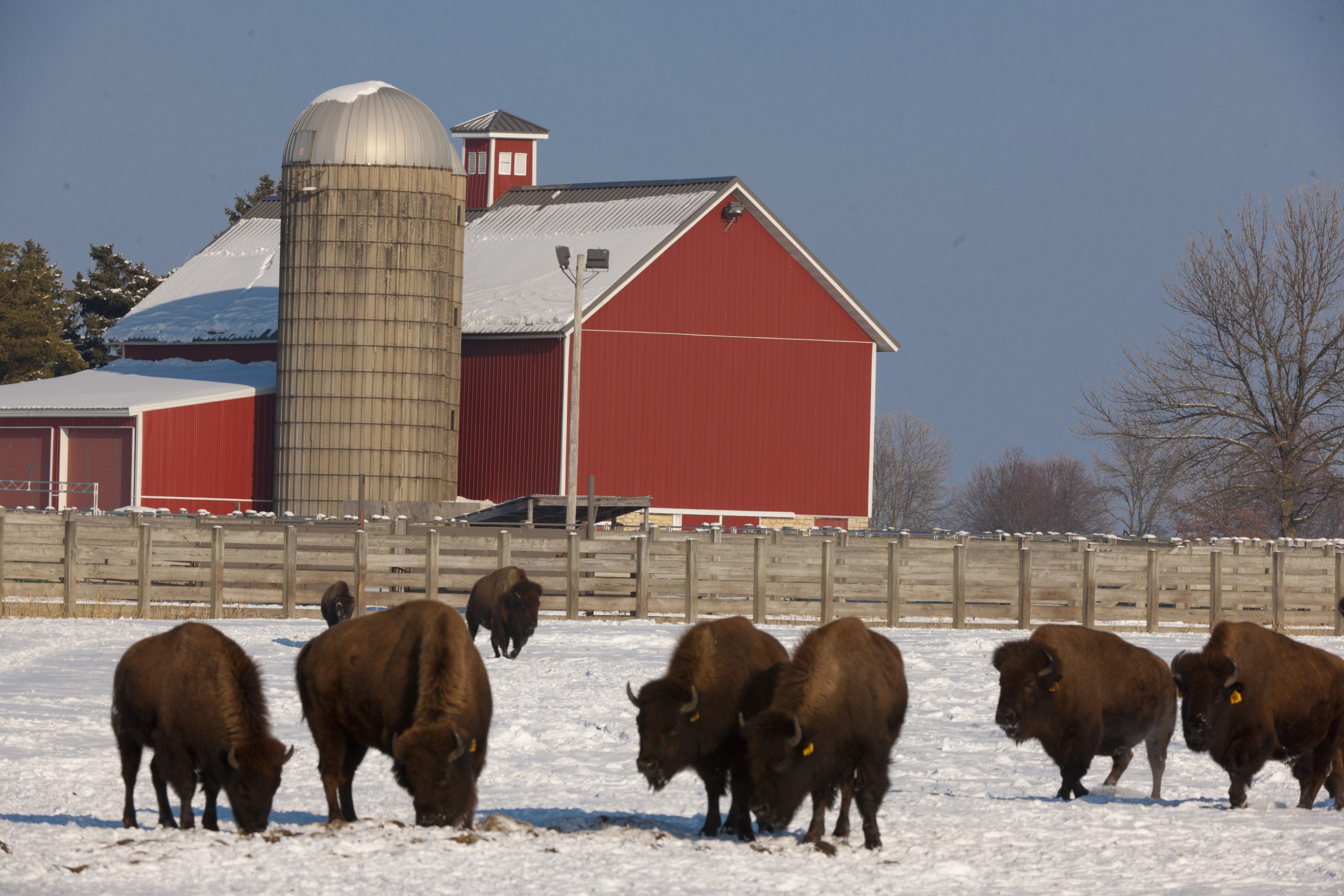A gourmet chef can’t prepare a delicious dish without the proper kitchen space, cutlery or fresh ingredients. Like meticulous chefs who analyze how each ingredient in the cooking process contributes to a dish’s flavor, quantum computing researchers follow a similar method to fabricate high-quality superconducting quantum devices.
Researchers from the Superconducting Quantum Materials and Systems Center, hosted by the U.S. Department of Energy’s Fermi National Accelerator Laboratory, are disentangling the architecture of quantum devices and studying each material to see how they affect the devices’ performance.
To achieve their goal, SQMS Center researchers are using the Pritzker Nanofabrication Facility at the University of Chicago. It’s a state-of-the-art user facility where researchers can fabricate superconducting quantum devices with different materials and processes.
“This is a great example of collaboration between the university and Fermilab with outstanding results,” said Juan de Pablo, University of Chicago executive vice president for science, innovation, national laboratories and global initiatives. “Fermilab’s scientists needed a state-of-the-art nanofabrication facility to advance their research, and they were able to conveniently access it through the university. Working together, we can scale projects like this one and answer questions in a field of vital importance.”
Turning access into results
Evaluating the performance of quantum devices will guide SQMS Center researchers toward understanding the origin of qubit performance limitations. The first results indicating the achievement of high-performance devices were reported this summer.
The big hurdle for making a working quantum computer: Quantum states are very fragile. Defects and properties of the materials that make up superconducting qubits are responsible for performance limitations.
“The Pritzker Nanofabrication Facility provides us access to an array of tools to experiment with different materials to extend the performance of our superconducting quantum devices,” said Mustafa Bal, head of SQMS Center nanofabrication. “Their support and ease of access allows the center to fabricate the devices needed to achieve our goal of building a quantum computer.”
“This is a great example of collaboration between the university and Fermilab with outstanding results …Working together, we can scale projects like this one and answer questions in a field of vital importance.” – Juan de Pablo, University of Chicago executive vice president
From proximity to progress
The SQMS Center comprises 23 partner institutions, with the National Institute of Standards and Technology and Rigetti Computing both providing access to their nanofabrication facilities. However, the Pritzker Nanofabrication Facility, located on the University of Chicago campus, is only an hour’s drive away from Fermilab. The close proximity allows SQMS Center researchers to construct their own superconducting quantum devices near the lab.
“We need to try many recipes, which require sophisticated tools and large throughput,” said Anna Grassellino, director of the SQMS Center. “By making devices in multiple foundries nationwide with a coordinated approach, we will accelerate toward making better qubits. Critically, we will also be able to verify how reproducible and systematic our results are and uncover hidden variables.”
To this end, the SQMS Center has established and launched a new nanofabrication taskforce within the center. It constitutes a large-scale, nationally coordinated effort toward qubit devices’ performance improvement.
Moreover, with access to this nearby fabrication facility, students and principal investigators at the SQMS Center can work together to design and fabricate superconducting quantum devices, thus training the next generation of quantum computing researchers.
“Being able to see the design of our quantum devices on the screen come to life through the work of our nanofab team enables us to test different qubit designs with different materials,” said Shaojiang Zhu, who leads the superconducting qubit design and simulation team. “Our first devices have shown high-quality factors, which paves the way to build better superconducting qubits.”
The Superconducting Quantum Materials and Systems Center is one of the five U.S. Department of Energy National Quantum Information Science Research Centers. Led by Fermi National Accelerator Laboratory, SQMS is a collaboration of 23 partner institutions—national labs, academia and industry—working together to bring transformational advances in the field of quantum information science. The center leverages Fermilab’s expertise in building complex particle accelerators to engineer multiqubit quantum processor platforms based on state-of-the-art qubits and superconducting technologies. Working hand in hand with embedded industry partners, SQMS will build a quantum computer and new quantum sensors at Fermilab, which will open unprecedented computational opportunities. For more information, please visit sqms.fnal.gov.
Fermi National Accelerator Laboratory is supported by the Office of Science of the U.S. Department of Energy. The Office of Science is the single largest supporter of basic research in the physical sciences in the United States and is working to address some of the most pressing challenges of our time. For more information, please visit science.energy.gov.
After four years, the assembly of a new neutrino detection system — about the size of a small, two-story house — at the U.S. Department of Energy’s Fermi National Accelerator Laboratory is complete. Built for the Short-Baseline Near Detector, the system will be moved across the Fermilab site from the assembly building to the detector hall in a few weeks.
Neutrinos are mysterious particles that could hold the key to answering many questions about our universe. Scientists have discovered three types of neutrinos. Results from some experiments suggest there might be more. As part of Fermilab’s Short-Baseline Neutrino Program, SBND will be one of three detectors to examine the behavior of neutrinos. Together, the detectors will measure short-distance neutrino oscillations with unprecedented precision. About 300 scientists from more than 50 institutions in Brazil, Italy, Paraguay, Spain, Switzerland, the United Kingdom and the United States, including CERN, work on this research..
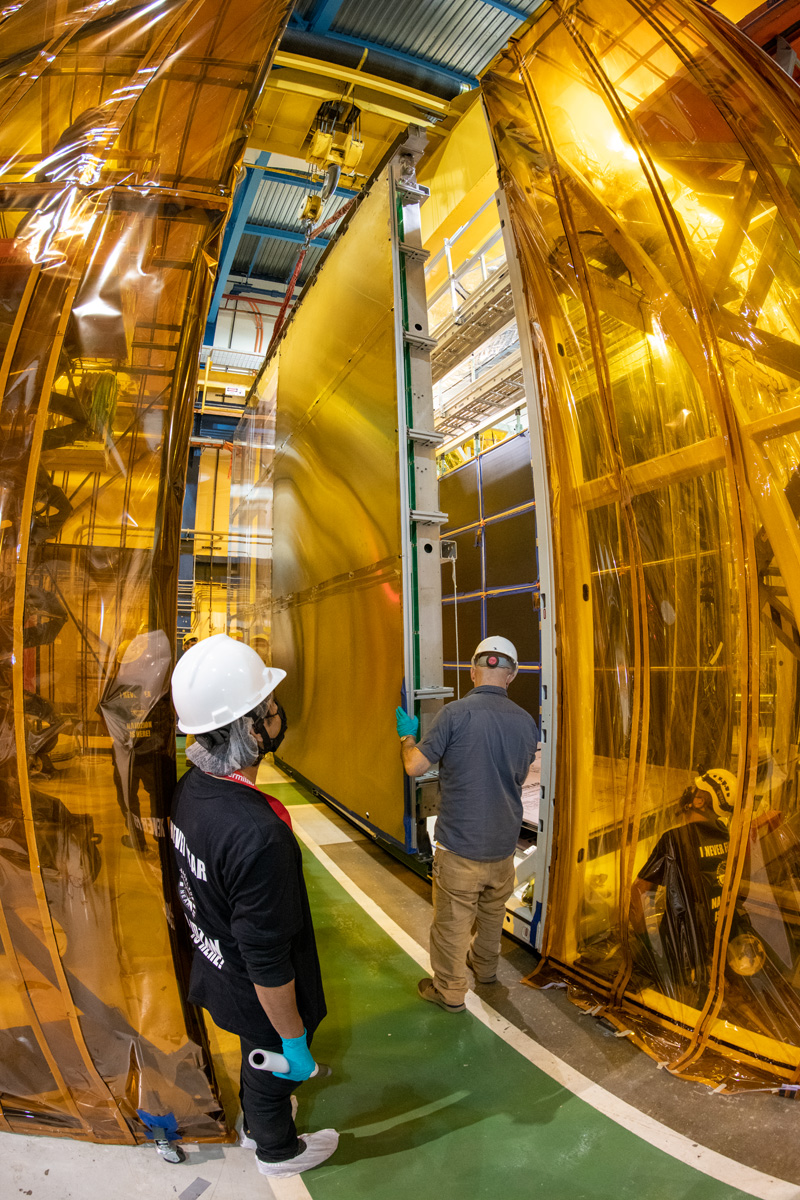
Installation of a wire plane in the neutrino detection system for the Short-Baseline Near Detector. Photo: Ryan Postel, Fermilab
The SBN Program incorporates three different liquid-argon time projection chamber detectors to detect neutrinos at different distances from the target facility that produces the neutrino beam for the measurements: SBND 110 meters away, MicroBooNE 470 meters away and ICARUS 600 meters away.
As neutrinos travel this distance, they could transform into a possible fourth type of neutrino, the sterile neutrino. This particle, if it exists, does not interact with ordinary, atomic matter, making it extremely difficult to detect. However, with three detectors at various distances from the target, scientists can check whether neutrinos transform, or oscillate, into each other on their way to the farthest detector. Any deviation from predictions made with the standard three-neutrino model could hint at the existence of a sterile neutrino or other new physics.
“Working with such a great, diverse group of people to put the detector together was just wonderful.” — Nicola McConkey, co-lead in charge of the detector assembly
Because SBND is the detector closest to the beam source, it will provide information on the original composition of the neutrino beam. Knowing the composition will give researchers a baseline measurement of the neutrino types present in the beam before they travel and reach the next two detectors. Scientists can then compare data between the three detectors and make observations based on the types of neutrino interactions in each detector down the line.
“By comparing what we see close to the source in the near detector with what we see in the far detector, we will understand if any oscillation is happening or not,” said Ornella Palamara, a neutrino scientist at Fermilab and co-spokesperson for the SBND collaboration.
Detecting these oscillations will answer the long-standing question about the existence of a possible fourth type of neutrino. A discrepancy in the amount of a neutrino flavor detected from one detector to the next would provide evidence for the existence of sterile neutrinos.
More science goals
The search for the sterile neutrino is not the only goal of the program. According to Palamara, SBND will also collect a very large amount of data on neutrino interactions with argon. Because argon has a relatively heavy nucleus, the interaction of a neutrino with its protons and neutrons is complex, and data is currently limited.
“We don’t have too many data on neutrino-argon interactions, so the SBN Program will be a generational advance into this,” she said. Other neutrino experiments that use liquid argon, such as the international Deep Underground Neutrino Experiment, hosted by Fermilab, will benefit from the knowledge gained by the SBN Program.

Thousands of wires spaced 3 millimeters apart make up each of the SBND planes that will detect signals created by neutrinos. Photo: Ryan Postel, Fermilab
The third goal of the program is to search for beyond-the-standard model physics. While the existence of sterile neutrinos is one explanation for anomalies seen in previous neutrino experiments, other theoretical models also provide potential explanations and will be put to the test with SBND and the SBN Program.
“We are working in close collaboration with many theorists,” Palamara said. “From this collaboration between us experimentalists and them, we will be able to test many of those models.”
Assembly process
Putting the detector together has been no small feat. Pieces of the detector were assembled all around the world, including the United Kingdom, Switzerland and Brazil, and had to be delicately transported to Fermilab. Along with the parts, teams from all over the world who were needed to assemble SBND also had to navigate traveling to Fermilab during the pandemic. Despite these challenges, working on the detector has been a rewarding experience for those involved.
“We had such a great group of people with a lot of positivity and just general camaraderie while working together in what was not the easiest of times,” said Nicola McConkey, a scientist at the University of Manchester and co-lead in charge of the detector assembly. “Working with such a great, diverse group of people to put the detector together was just wonderful.”
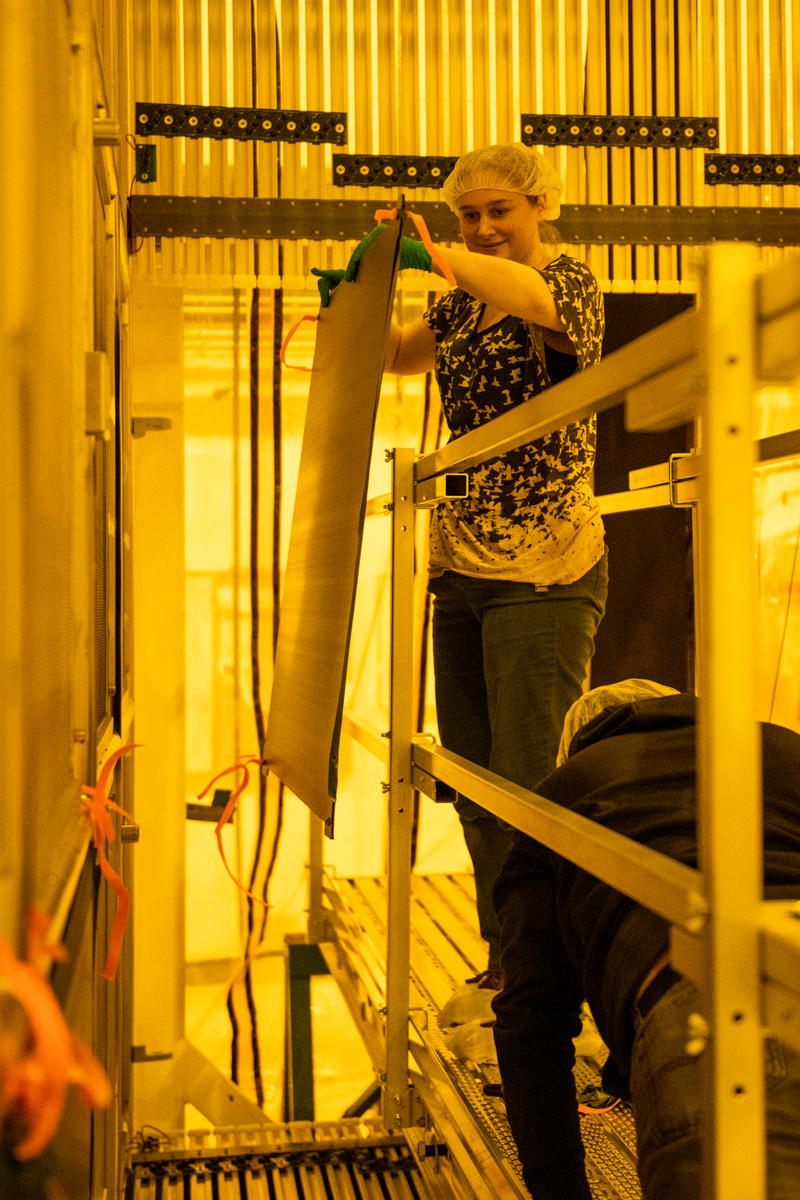
Nicola McConkey is the co-lead in charge of the assembly of the neutrino detection system for SBND. Detector components were assembled all around the world and had to be delicately transported to Fermilab. Photo: Ryan Postel, Fermilab
McConkey has been part of SBND since the early days of the project and has been able to see the development of the pieces from the U.K. from their manufacturing to installation in the detector.
“It was really helpful to see how everything was built,” she said. “That gave me a lot of insight into how it should go together and the potential problems that we had to watch out for.”
The assembly took place inside a cleanroom constructed with yellow plastic panes to keep the assembly process free of dust and harmful ultraviolet light. The team celebrated as they reached milestones, such as installing the two anode wire planes on either side of the detector and taking the protective covers off of the cathode plane.
“It’s been really nice seeing things that we only saw in models actually in existence,” McConkey said.
Final touches
The last parts to be assembled were the light detection systems. They will capture the scintillation light that is produced when neutrinos interact with argon atoms. Traditional photomultiplier tubes are being used along with new silicon-based devices, called ARAPUCA, which trap photons with filters.
“Photons, when entering this device, are not able to get out because of the cutoff of the filter,” said Ana Machado, who designed the ARAPUCA technology and has overseen the manufacture of the devices for SBND. “After some reflections, the photons are detected by silicon photomultipliers.”
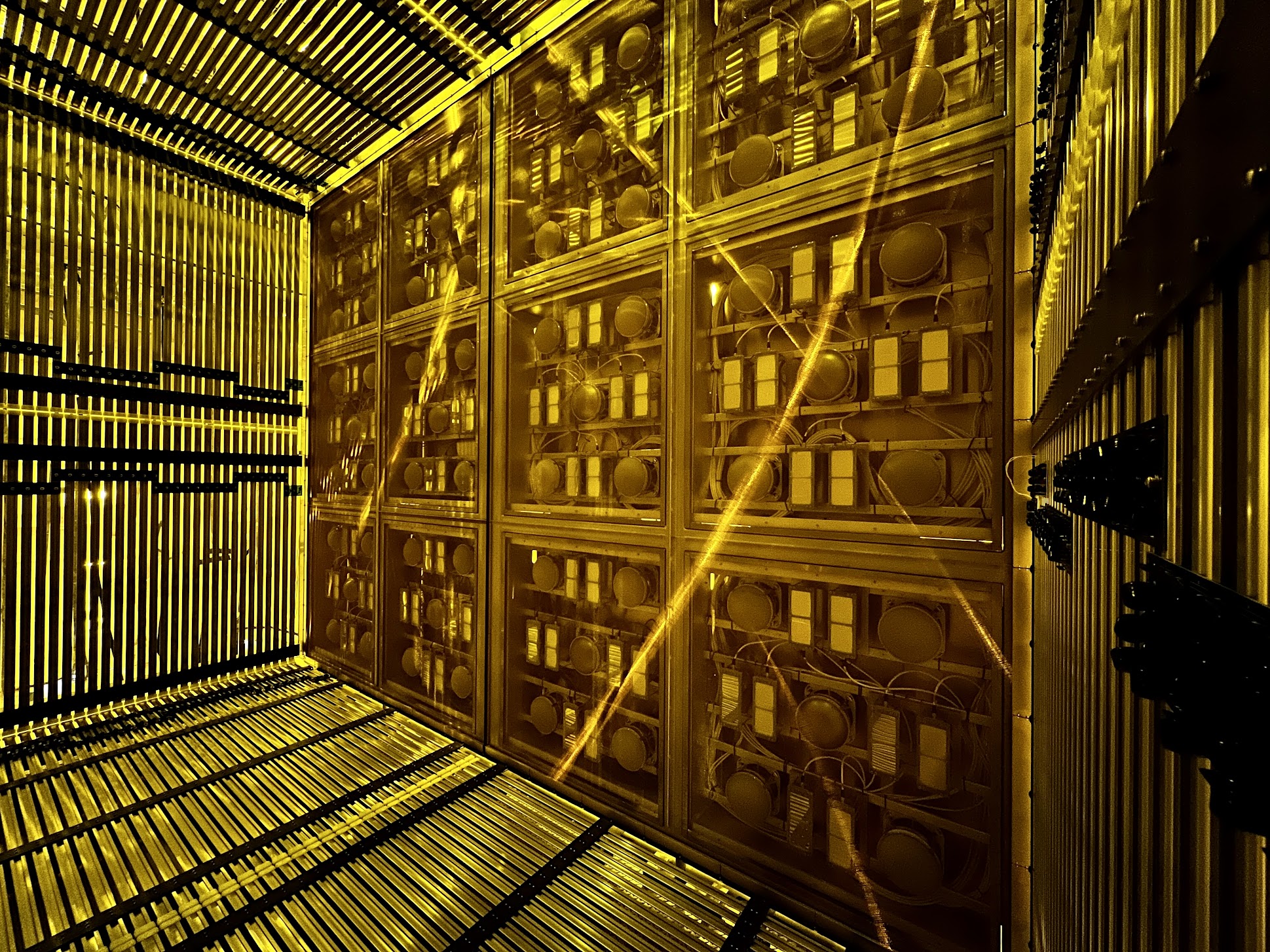
The light detection systems of the Short-Baseline Near Detector comprise silicon-based devices as well as traditional photomultiplier tubes. Photo: SBND collaboration
SBND will use a modified design of the original ARAPUCA technology, called X-ARAPUCA. SBND will be the first detector in which neutrino interactions will be detected with this upgraded technology. X-ARAPUCAs will also be deployed in the detectors for the Deep Underground Neutrino Experiment. Installing and using the new devices in SBND will serve as an important test for their use in DUNE.
The next step will be to move the assembled neutrino detection system to the detector hall and lower it into the cryostat for SBND — the vessel that will house the system together with 112 tons of liquid argon. The cryostat will keep the argon at extremely cold temperatures to maintain it in its liquid state.
The SBND collaboration plans to have the full detector ready for commissioning in the summer of 2023.
Fermi National Accelerator Laboratory is supported by the Office of Science of the U.S. Department of Energy. The Office of Science is the single largest supporter of basic research in the physical sciences in the United States and is working to address some of the most pressing challenges of our time. For more information, please visit science.energy.gov.
The U.S. Department of Energy allocated funds to its 17 national laboratories from the Inflation Reduction Act to mitigate the rise of project costs as a result of inflation. Fermilab will spend the funding on the lab’s on-going construction projects. This will allow the lab’s major projects to uphold their schedules and keep their commitment to international collaborators.
The U.S. Department of Energy’s Fermi National Accelerator Laboratory will receive $260 million in funding due to the Inflation Reduction Act (IRA) of 2022. The funding was designated by the DOE’s Office of Science and allows the lab’s construction projects to lock in construction costs that otherwise could rise due to inflation.
“America’s commitment to science and ingenuity shaped us into the world leaders we are today, and the continued success of our national laboratories will ensure we’re at the global forefront of innovation for generations to come,” said U.S. Secretary of Energy Jennifer M. Granholm. “Thanks to President Biden’s Inflation Reduction Act, these world-class institutions will receive $1.5 billion — one of the largest ever investments in national laboratory infrastructure — to develop advanced energy and manufacturing technologies we need to advance the frontiers of science and tackle tomorrow’s challenges.”
On Friday, Nov. 4, at 2:00 p.m. CT, Secretary Granholm and other DOE officials will visit Argonne National Laboratory and will host a live webinar event on the critical role DOE and the national labs play in the newly released White House report on U.S. Innovation to Meet 2050 Climate Goals.
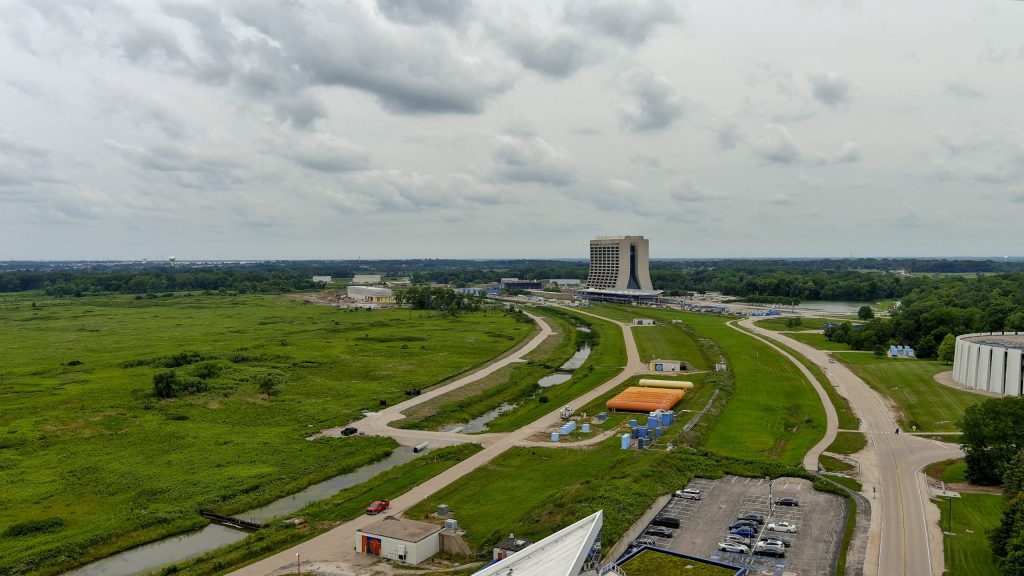
Fermilab will receive funding from the Inflation Reduction Act of 2022 to mitigate rising project costs as a result of inflation. Photo: Ryan Postel, Fermilab
The IRA funding allocated to Fermilab provides support for several, on-going construction projects. It will allow the lab’s flagship project, the Long-Baseline Neutrino Facility, to stay on track and maintain its construction schedule. By doing so, Fermilab will continue moving forward with construction of the LBNF facility, which will house the international Deep Underground Neutrino Experiment at Fermilab and in Lead, South Dakota. The DUNE experiment, when complete, will perform research probing the fundamental properties of matter in the universe.
“I’m extremely grateful for the Department of Energy in allocating this funding to our laboratory,” said Fermilab Director Lia Merminga. “This money will allow us to mitigate the effects of inflation, deliver projects and scientific results on time, and honor our commitments to national and international partners.”
Funding will also help Fermilab deliver on its commitments to CERN, the research center that operates the largest particle physics laboratory in the world, in contributing to the high-luminosity upgrades to the Large Hadron Collider and its experiments. With the funding, Fermilab will be able to build and ship equipment as planned to allow more than 1,000 scientists and graduate students in the United States to continue their work on the LHC to understand the nature of matter and energy.
The IRA funding will increase support to the Muon-to-Electron conversion experiment. This will keep the project on track for completion by 2025, meeting critical deadlines and staying ahead of international competition.
“In the next five years, Fermilab expects to invest more than $500 million dollars in the construction of new buildings and infrastructure on site, creating many jobs,” added Merminga. “With the IRA funding, we now have the assurance that we can continue our projects on their planned schedules.”
Fermilab is one of the 17 DOE national laboratories and is the premier laboratory for particle physics and particle accelerators in the United States. The laboratory has one of the largest portfolios of construction projects in the DOE Office of Science.
Fermi National Accelerator Laboratory is America’s premier national laboratory for particle physics and accelerator research. A U.S. Department of Energy Office of Science laboratory, Fermilab is located near Chicago, Illinois, and operated under contract by the Fermi Research Alliance LLC, a joint partnership between the University of Chicago and the Universities Research Association, Inc. Visit Fermilab’s website and follow us on Twitter at @Fermilab.
Each with a pair of big brown eyes and encapsulated in a thick mat of hair are the American plains bison that roam the U.S. Department of Energy’s Fermi National Accelerator Laboratory’s 80-acre pasture. Since the introduction of the herd in 1969, these large mammals have become a cornerstone of the lab’s culture. A living homage, the bison represent the former frontier of the Midwestern prairie and symbolize the scientific frontier Fermilab researchers explore in the field of high-energy physics.
Since Fermilab’s first director, Robert Wilson, established the bison herd at the lab, locals and visitors alike have enjoyed seeing these magnificent animals. Often captured in photos or now seen through the virtual bison cam, the iconic bison is the lab’s unofficial mascot. During the spring, you might lay eyes on an adult female caring for her calf, otherwise known as a “red dog,” or in early winter catch a glimpse of light snowfall collecting atop the mammal’s brown fur. It’s especially exciting any time of year when the herd grazes near the fence line along Pine Street, affording closer viewing and better photo opportunities.
In 2013, the U.S. Senate passed its first National Bison Day Resolution. Observed on the first Saturday in November, National Bison Day falls on Saturday, Nov. 5, this year.
Serving as a symbol for abundance and manifestation, the bison was declared the national mammal of the United States six years ago.
Let’s celebrate our national mammal and take a look at Fermilab’s bison herd over the years.
On April 28, 2016, Congress passed the National Bison Legacy Act, recognizing this iconic animal as a symbol of historical significance. President Obama signed it into law on May 9, 2016, and the bison officially became the national mammal of the United States.
The lab purchased its first bison in 1969. Fermilab received its first bull from a breeder in Cheyenne, Wyoming, and added four cows and their calves from another breeder in Longmont, Colorado.
The purpose of Fermilab’s bison herd is to preserve and restore a bit of Illinois heritage that was here some 200 years ago. Robert Wilson, Fermilab’s first director, established the bison herd in 1969 as a symbol of the history of the Midwestern prairie and the lab’s pioneering research at the leading edge of particle physics. The herd gathers in front of the red barn in December 2010.
By the late 1880s, the plains bison population in the United States was decimated, driven nearly to extinction. Thanks to conservation efforts, like those at Fermilab and elsewhere, the bison has rebounded. It is no longer an endangered species, but conservation of the bison genome is still a federally recognized priority. Some of the Fermilab herd in 2016.
Mid-November 2018 started off with a dusting of snow and a beastly move-in of two new bison bulls to Fermilab. Since 1971, the herd’s genetic diversity has been augmented by rotating the bulls, selling them and bringing in new bloodlines every five to seven years. In 2016, the lab learned the Fermilab bison herd is 100% pure bison with no cattle genes in the mix.
In 1973, the Fermilab herdsmen began a tagging and sorting program, designed to help keep the bison herd healthy. Note the tag on the bison’s ear.
Each spring, Fermilab’s first baby bison of the year is widely heralded. In a tradition followed since the herd’s creation, the herdsman notifies the lab director and other leaders about its arrival and the status of the mother. Newly birthed, this baby bison takes the spotlight on April 20, 2019, as the first newborn of the year.
The largest land mammal in North America, bison are powerful creatures. Bulls like this one can weigh up to 2,000 pounds, while cows are smaller at 1,000 pounds. Bison range in height from 5 to 6 feet tall and 10 to 12 feet long. Don’t let their size deceive you: Not only are they fast — bison can run up to 35 miles per hour! — they’re also nimble and can jump up to 6 feet vertically and 7 feet horizontally.
Bison are uniquely built to endure bitter cold and deep snows. In 2015, the lab experienced a heavy snowfall. Trudging through the thick snow may have winded this large bison, who stuck out his tongue to force more air into his lungs.
Nearly 30 bison comprised the herd in spring 2022, and 23 calves were born this year, starting in April.
Early spring 2022 brought forth the first red-haired baby bison, seen here with its mother.
Recently born baby bison huddle near the safety of their mothers circa 1994. Bison cows are fiercely protective of their young.
While grazing in the sun, a mother bison minds her calf in May 2011. She’ll feed her baby until it weans at about 6 months of age.
Fermilab’s bison herd continues to attract visitors young and old. A children’s tour takes place at the Buffalo Barn in 1983.
Fermilab remains committed to maintaining its famous herd. Here, Wilson Hall touches the sky in the distance, while mother and baby bison touch noses in Fermilab’s multi-acre greenery during mid-April 2021.
Fermi National Accelerator Laboratory is supported by the Office of Science of the U.S. Department of Energy. The Office of Science is the single largest supporter of basic research in the physical sciences in the United States and is working to address some of the most pressing challenges of our time. For more information, please visit science.energy.gov.
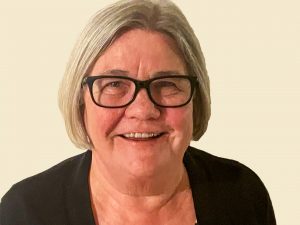
In her new role with the DOE’s Office of Science, Gina Rameika will oversee all high-energy physics research activities in the United States. Photo: Gina Rameika.
The U.S. Department of Energy’s Office of Science recently announced that Regina “Gina” Rameika has accepted the role of associate director for its Office of High Energy Physics. In her new role, Rameika will oversee all high-energy physics research activities in the United States at both national laboratories as well as universities. She joins the DOE Office of Science on Nov. 7.
“Gina has demonstrated tremendous leadership in the national laboratory environment with DOE projects and with international science collaborations,” said Asmeret Asefaw Berhe, director of the Office of Science. “We are thrilled to have Gina join the Office of Science, given her vast experience and skilled leadership.”
Rameika hails from the DOE’s Fermi National Accelerator Laboratory where, as a distinguished scientist, she spent much of her career in neutrino science and experimental particle physics. Her responsibilities have ranged from managing particle detector construction projects to leading the Deep Underground Neutrino Experiment, the international science collaboration that plans to carry out the world-leading experiment currently under construction as part of the DOE Long-Baseline Neutrino Facility/DUNE-US Project.
Some of her roles at Fermilab included serving as project manager for the Long-Baseline Neutrino Experiment and for the MicroBooNE Project, as well as the head of Fermilab’s Neutrino Division. She was also an elected spokesperson of the 1,400-member international DUNE collaboration, in addition to serving as the DUNE resource coordinator and construction coordinator.
“I’m excited to step into this new position,” said Rameika. “I will always value my time at Fermilab and truly appreciate having worked hands-on with the international DUNE collaboration. I believe that serving as the associate director of HEP, I can bring these experiences and lessons learned to help increase and advance physics research in the U.S.”
Rameika has a bachelor’s degree and doctorate in physics from Rutgers University in New Brunswick, New Jersey. She has also received multiple awards, including most recently, the 2022 APS Panofsky Prize for contributions to the DONUT Experiment and a 2019 Fermilab Trailblazer Award for contributions to the Long-Baseline Neutrino program.
Fermi National Accelerator Laboratory is supported by the Office of Science of the U.S. Department of Energy. The Office of Science is the single largest supporter of basic research in the physical sciences in the United States and is working to address some of the most pressing challenges of our time. For more information, please visit science.energy.gov.
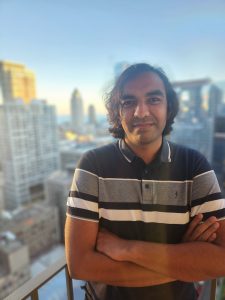
Always looking for a new trail to ride his bike on or an opportunity to catch a live show in town, Sajid Ali Syed is a research associate in computational science and AI for high-energy physics applications at Fermilab. Photo: Sajid Ali Syed
How long have you been at the U.S. Department of Energy’s Fermi National Accelerator Laboratory?
I joined Fermilab last October. It has been just over a year now.
How did you get interested in physics?
I did electrical engineering for my undergrad. When I first applied for the Ph.D., I thought I would be doing something related to condensed matter physics, but I changed to X-ray imaging. There, I worked on computational X-ray optics and the development of new techniques for nanoscale biological imaging.
Part of the consequences of the pandemic was that I dropped some of these plans for doing more computational work. Now, here at Fermilab I’m doing scientific computing mostly.
Please describe your work. What are the projects you’re working on now?
Currently, I am working on two projects for SciDAC, which is the U.S. Department of Energy’s Scientific Discovery through Advanced Computing program. One of them deals with a software that simulates how the accelerators work, specifically looking at how the beam interacts with itself or how the beam is shaped by the different kinds of accelerator elements. This will help provide understanding in how the accelerator will be upgraded in the future.
The other project that I’m working on aims to use [high-performance computing] resources to analyze [high-energy physics] data. Traditionally, HEP data is analyzed on grid computing resources, and now we are using HPC/supercomputers that are quite different. We are developing new ways to analyze data by leveraging novel software paradigms to reduce processing times.
What’s the most rewarding part of your job?
These frameworks that we use today are going to be useful for experiments that are yet to be undertaken. We ensure that our software is reusable, and our results are repeatable. This will enable researchers to build upon the work that we are doing in the future.
What is the most challenging part of your work?
While I was doing my Ph.D., I was mostly working by myself on a not-very-big team, and now it is really rewarding to see how everyone is working together when some people know physics and others don’t.
What do you like best about working at Fermilab?
I got my Ph.D. at Northwestern University and worked a lot at Argonne National Lab through my advisor, so I had experience working at national labs. Fermilab was quite similar but different when coming in.
What I like the most about Fermilab is how the scope of research is much bigger than what it could be if one were to work at an academic lab. I also like being part of a team that develops software tools that impact a wide variety of experiments.
What do you do outside the lab for fun? What do you like to do when you are not at work?
I like to bike, play board games and catch live music performances when possible.
Fermi National Accelerator Laboratory is supported by the Office of Science of the U.S. Department of Energy. The Office of Science is the single largest supporter of basic research in the physical sciences in the United States and is working to address some of the most pressing challenges of our time. For more information, please visit science.energy.gov.
